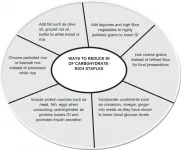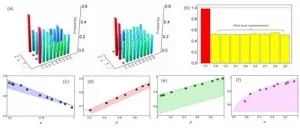(Press-News.org) The models used to produce global climate scenarios may overestimate the energy and emission savings from improved energy efficiency, warns new research led by academics at the University of Sussex Business School and the University of Leeds.
In a review of 33 studies, the researchers find that economy wide rebound effects may erode around half of the energy and emission savings from improved energy efficiency.
These rebound effects result from individuals and businesses responding to the benefits of improved energy efficiency - such as cheaper heating, lighting and travel. These responses improve quality-of-life, raise productivity and boost industrial competitiveness, but they also reduce the economy-wide energy savings.
The new study argues that economy-wide rebound effects are larger than commonly assumed, which may partly explain the close links between energy consumption and GDP over the past 100 years.
Improved energy efficiency is expected to play a central role in meeting the goals of the Paris Agreement, contributing up to 40% of the envisaged reductions in global greenhouse gas (GHG) emissions over the next two decades.
However, the new research suggests that the models used by the Intergovernmental Panel on Climate Change (IPCC), the International Energy Agency (IEA) and others fail to adequately capture these rebound effects. As a result, their scenarios may underestimate future global energy demand. In the absence of policies to mitigate rebound effects, this could make the Paris Agreement targets harder to achieve.
The authors argue that global energy modellers need to take rebound effects more seriously, and to find ways of capturing the full range of effects within their scenarios. They also recommend the use of carbon pricing to limit rebound effects and the targeting of energy efficiency policies to maximise their economic and environmental benefits.
Steve Sorrell, Professor of Energy Policy in the Science Policy Research Unit (SPRU) at the University of Sussex Business School, said: "Rebound effects are notoriously difficult to estimate, but our understanding has improved enormously over the last decade. What we show here is that 33 studies from different countries using very different methodologies all reach broadly the same conclusion - namely that economy-wide rebound effects are large. Unfortunately, the models we rely upon to produce global energy and climate scenarios do not adequately capture these effects. This needs to change."
Dr Paul Brockway, University Academic Fellow in the School of Earth and Environment at the University of Leeds, said: "If global energy use is higher than we expect, we may need to place more reliance on low-carbon energy supply and negative emission technologies to meet our climate goals. This will require political will, ambitious policies, large-scale investment, extensive land use, and crucially, significant lead times. We therefore need to take rebound effects seriously - and to find ways to maximise energy savings whilst continuing to improve quality-of-life."
In a new paper published today in Renewable and Sustainable Energy Reviews, the researchers find that many of the global energy scenarios that meet the Paris Agreement goals anticipate little or no growth in global energy demand despite continued growth in incomes.
However, there is little precedent for such significant 'decoupling' of energy consumption from GDP. Only a small number of countries have managed to grow their economies whilst reducing energy use, and then for only short periods of time. Current global trends are in the opposite direction with global energy consumption rising rapidly in the years prior to the Covid pandemic.
The team of researchers, comprising academics from the University of Leeds, University of Sussex, University of Massachusetts Amhurst, Calvin University, IFP Energies Nouvelles and Institut Louis Bachelier, reviewed 21 studies that used macroeconomic models to estimate the economy-wide rebound effects from a variety of energy efficiency improvements in different countries and sectors.
They found that 13 of the 21 studies using a common approach of 'computable general equilibrium' modelling estimated rebound effects of 50% or more - implying that over half the potential energy savings were 'taken back' by various economic and behavioural responses. The mean estimate of rebound effects from these studies was 58% and the median estimate was 55%, with some studies finding that the energy savings were eliminated altogether.
The team also reviewed 12 other studies that used a variety of other methods to estimate economy-wide rebound effects, and found these gave an even larger mean estimate of 71%.
The team then reviewed four of the 'integrated assessment models' used by the IPCC, together with the global energy models used by bp, Shell, the International Energy Agency (IEA) and the US Energy Information Administration (EIA). They found that most of these models only captured some of the mechanisms contributing to rebound effects, or included them in a simplified manner. Moreover, in some cases the process of calibrating scenarios largely precluded the investigation of rebound effects.
Dr Gregor Semieniuk, Assistant Research Professor at the University of Massachusetts Amherst, said: "Global energy models risk overestimating the potential for energy savings if they do not fully account for the multiple channels of the economy wide rebound. Nearly all the scenarios for keeping global temperature increase to a manageable level rely on heavily improved energy efficiency so understanding the potential for rebound - and what mitigates it - is critical. Now is the time to re-examine rebounds in global climate scenarios to ensure that our expectations for energy savings are well-founded."
INFORMATION:
Professor Christiani Jeyakumar Henry, Senior Advisor of Singapore Institute of Food and Biotechnology Innovation (SIFBI), Agency for Science, Technology and Research (A*STAR) and his team have developed a Glycaemic Index (GI) glossary of non-Western foods. The research paper (attached PDF) was published in Nutrition & Diabetes on 6 Jan 2021: https://doi.org/10.1038/s41387-020-00145-w.
Observational studies have shown that the consumption of low glycaemic index (GI) foods is associated with a lower risk of type 2 diabetes mellitus (T2DM), significantly less insulin resistance and a lower prevalence of the metabolic syndrome. ...
Recently, research team led by academician GUO Guangcan from CAS Key Laboratory of Quantum Information of the University of Science and Technology of China (USTC) of CAS, has made an important progress in quantum information theory. Prof. LI Chuanfeng and Prof. XIANG Guoyong from the team, cooperated with Dr. Strelstov from University of Warsaw, investigated the imaginary part of quantum theory as a resource, and several important results have been obtained. Relevant results are now jointly published as Editors' Suggestion in Physical Review Letters and Physical Review A.
Complex number is a mathematical ...
It is millions of trillions of times brighter than the sunlight and a whopping 1,000 trillionth of a second, appropriately called the instantaneous light. It is the X-ray Free Electron Laser (XFEL) light that opens a new scientific paradigm. Combining it with AI, an international research team has succeeded in filming and restoring the 3D structure of nanoparticles that share structural similarities with viruses. With the fear of a new pandemic growing around the world due to COVID-19, this discovery is attracting the attention among academic circles for imaging the structure of the virus with both high accuracy and speed.
An international team of researchers from POSTECH, National University of ...
Targeted, efficient and with few side effects: A new method for combating periodontitis could render the use of broad-spectrum antibiotics superfluous. It was developed and tested for the first time by a team from Martin Luther University Halle-Wittenberg (MLU), the Fraunhofer Institute for Cell Therapy and Immunology IZI and Periotrap Pharmaceuticals GmbH. The aim is to neutralise only bacteria that cause periodontitis while sparing harmless bacteria. The study appeared in the Journal of Biological Chemistry.
Periodontitis is a common bacterial inflammation of the gums. According to the World Health Organization WHO Oral ...
Ask Eric Weaver about pandemics, and he's quick to remind you of a fact that illustrates the fleeting nature of human memory and the proximal nature of human attention: The first pandemic of the 21st century struck not in 2019, but 2009.
That's when the H1N1/09 swine flu emerged, eventually infecting upwards of 1.4 billion people -- nearly one of every five on the planet at the time. True to the name, swine flus jump to humans from pigs. It's a phenomenon that has been documented more than 400 times since the mid-2000s in the United States alone.
"They're considered the great mixing vessel," said Weaver, associate professor of biological sciences at the University of Nebraska-Lincoln. "They're susceptible to their own circulating ...
Parents who reported more hassles using a child car seat or booster seat - such as the child is uncomfortable or having to make multiple trips in a day - were less likely to follow recommendations from the American Academy of Pediatrics (AAP) on child passenger safety, according to a study published in the journal Academic Pediatrics.
Researchers obtained information about transportation safety behaviors and 20 hassles when using child car seats among 238 socioeconomically and racially diverse parents of children 1 to 10 years of age. Eighty percent of parents reported at least a little bit of a problem with one ...
Neurodegenerative disorders such as Parkinson's and Alzheimer's disease are in the firing line after researchers identified an attractive therapeutic drug target.
An international collaboration, co-led by University of Queensland researchers, has isolated and analysed the structure and function of a protein found in the brain's nerve fibres called SARM1.
Dr Jeff Nanson said the protein was activated when nerve fibres were damaged by injury, disease, or as a side effect of certain drugs.
"After a damaging incident occurs, this protein often induces ...
Fireworks are used in celebrations around the world, including Independence Day in the U.S., the Lantern Festival in China and the Diwali Festival in India. However, the popular pyrotechnic displays emit large amounts of pollutants into the atmosphere, sometimes causing severe air pollution. Now, researchers reporting in ACS' Environmental Science & Technology have estimated that, although so-called environmentally friendly fireworks emit 15-65% less particulate matter than traditional fireworks, they still significantly deteriorate air quality.
Fireworks displays can cause health problems, such as respiratory ailments, because they ...
Wine lovers recognize that a perfectly paired wine can make a delicious meal taste even better, but the reverse is also true: Certain foods can influence the flavors of wines. Now, researchers reporting in ACS' Journal of Agricultural and Food Chemistry have explored how lipids -- fatty molecules abundant in cheese, meats, vegetable oils and other foods -- interact with grape tannins, masking the undesirable flavors of the wine compounds.
Tannins are polyphenolic compounds responsible for the bitterness and astringency of red wines. Wine testers have noticed that certain foods reduce these sensations, improving the flavor of a wine, but scientists aren't sure why. Some studies have ...
DALLAS, March 3, 2021 -- American Indian people with atrial fibrillation (AFib) had the highest risk of non-hemorrhagic stroke when compared with people in other racial and ethnic groups, and they also experienced the highest overall risk for stroke even without atrial fibrillation (AFib), according to new research published today in the Journal of the American Heart Association, an open access journal of the American Heart Association.
"In previous research, we have confirmed that American Indian individuals, when compared with those in other racial or ethnic groups, have the highest risk of atrial fibrillation, which is a quivering or irregular heartbeat that can substantially increase the risk of blood clots and stroke," said lead study ...





